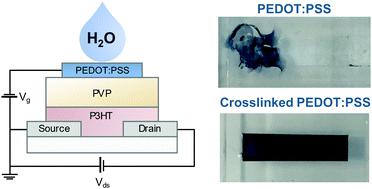当前位置:
X-MOL 学术
›
J. Mater. Chem. C
›
论文详情
Our official English website, www.x-mol.net, welcomes your
feedback! (Note: you will need to create a separate account there.)
Stable crosslinked gate electrodes for hygroscopic insulator OTFT sensors
Journal of Materials Chemistry C ( IF 5.7 ) Pub Date : 2021-6-3 , DOI: 10.1039/d1tc00862e Joshua N. Arthur 1, 2, 3, 4, 5 , Cameron M. Cole 1, 2, 3, 4, 5 , Ajay K. Pandey 3, 4, 6, 7, 8 , Soniya D. Yambem 1, 2, 3, 4, 5
Journal of Materials Chemistry C ( IF 5.7 ) Pub Date : 2021-6-3 , DOI: 10.1039/d1tc00862e Joshua N. Arthur 1, 2, 3, 4, 5 , Cameron M. Cole 1, 2, 3, 4, 5 , Ajay K. Pandey 3, 4, 6, 7, 8 , Soniya D. Yambem 1, 2, 3, 4, 5
Affiliation

|
Organic thin film transistors, employing diverse device architectures, materials and form factors, have been demonstrated as effective sensors of a variety of analytes, including ions. In many such devices, it is essential to use materials with both electronic conductivity and ion permeability, that are also stable under aqueous conditions. Hygroscopic insulator field effect transistors (HIFETs) are simple, solution processable, and low-voltage transistors with promising sensing properties when the analyte is introduced into the device through a permeable top gate electrode. It is important that the gate electrode is water stable, to prevent loss or damage to the electrode in aqueous conditions and ensure consistent performance. Here, we report two different methods to fabricate stable gate electrodes for HIFETs using crosslinked PEDOT:PSS, a conductive and ion-permeable polymer. We compare the two common crosslinkers, divinyl sulfone (DVS) and (3-glycidyloxypropyl)trimethoxysilane (GOPS), and present methods to overcome challenges associated with using either for crosslinking a top gate electrode. We show that DVS crosslinking can take place at room temperature, but freestanding films need to be formed separately then attached to the transistor to avoid damage to underlying layers by the crosslinker. GOPS crosslinking requires high temperatures but can be done in situ and bonds well to underlying layers. Using these optimised methods, we show that the stable PEDOT:PSS films perform well as gate electrodes for HIFET sensors. Our report is a significant step forward in the development of stable HIFET-based sensors, and our methods may have broader applicability to similar stable organic electronic devices.
中文翻译:

用于吸湿绝缘体 OTFT 传感器的稳定交联栅电极
有机薄膜晶体管采用不同的器件结构、材料和形状因子,已被证明是多种分析物(包括离子)的有效传感器。在许多此类设备中,必须使用具有电子导电性和离子渗透性的材料,这些材料在水性条件下也很稳定。吸湿绝缘体场效应晶体管 (HIFET) 是一种简单、可溶液处理的低压晶体管,当分析物通过可渗透的顶栅电极引入器件时,具有良好的传感特性。重要的是栅电极是水稳定的,以防止电极在含水条件下丢失或损坏并确保一致的性能。在这里,我们报告了使用交联 PEDOT:PSS 为 HIFET 制造稳定栅电极的两种不同方法,一种导电且可渗透离子的聚合物。我们比较了两种常见的交联剂,二乙烯基砜 (DVS) 和(3-缩水甘油氧基丙基)三甲氧基硅烷 (GOPS),并提出了克服与使用任何一种交联顶栅电极相关的挑战的方法。我们表明 DVS 交联可以在室温下发生,但独立薄膜需要单独形成,然后连接到晶体管上,以避免交联剂损坏底层。GOPS 交联需要高温但可以完成 但是独立的薄膜需要单独形成,然后连接到晶体管上,以避免交联剂损坏底层。GOPS 交联需要高温但可以完成 但是独立的薄膜需要单独形成,然后连接到晶体管上,以避免交联剂损坏底层。GOPS 交联需要高温但可以完成原位并与下层粘合良好。使用这些优化方法,我们表明稳定的 PEDOT:PSS 薄膜作为 HIFET 传感器的栅电极表现良好。我们的报告是在开发基于 HIFET 的稳定传感器方面向前迈出的重要一步,我们的方法可能对类似的稳定有机电子设备具有更广泛的适用性。
更新日期:2021-06-09
中文翻译:

用于吸湿绝缘体 OTFT 传感器的稳定交联栅电极
有机薄膜晶体管采用不同的器件结构、材料和形状因子,已被证明是多种分析物(包括离子)的有效传感器。在许多此类设备中,必须使用具有电子导电性和离子渗透性的材料,这些材料在水性条件下也很稳定。吸湿绝缘体场效应晶体管 (HIFET) 是一种简单、可溶液处理的低压晶体管,当分析物通过可渗透的顶栅电极引入器件时,具有良好的传感特性。重要的是栅电极是水稳定的,以防止电极在含水条件下丢失或损坏并确保一致的性能。在这里,我们报告了使用交联 PEDOT:PSS 为 HIFET 制造稳定栅电极的两种不同方法,一种导电且可渗透离子的聚合物。我们比较了两种常见的交联剂,二乙烯基砜 (DVS) 和(3-缩水甘油氧基丙基)三甲氧基硅烷 (GOPS),并提出了克服与使用任何一种交联顶栅电极相关的挑战的方法。我们表明 DVS 交联可以在室温下发生,但独立薄膜需要单独形成,然后连接到晶体管上,以避免交联剂损坏底层。GOPS 交联需要高温但可以完成 但是独立的薄膜需要单独形成,然后连接到晶体管上,以避免交联剂损坏底层。GOPS 交联需要高温但可以完成 但是独立的薄膜需要单独形成,然后连接到晶体管上,以避免交联剂损坏底层。GOPS 交联需要高温但可以完成原位并与下层粘合良好。使用这些优化方法,我们表明稳定的 PEDOT:PSS 薄膜作为 HIFET 传感器的栅电极表现良好。我们的报告是在开发基于 HIFET 的稳定传感器方面向前迈出的重要一步,我们的方法可能对类似的稳定有机电子设备具有更广泛的适用性。


















































 京公网安备 11010802027423号
京公网安备 11010802027423号